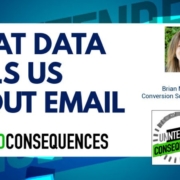The Superstitions That Keep You From E-mail Success
If you’re considering investing in a social marketing campaign, and you haven’t nailed your e-mail strategy, you may be investing in the wrong place.
I don’t think business owners and marketers are dumb. I think that they’re just superstitious. Like walking under a ladder, they fear that if they really step up their e-mail strategy, they’ll come to some sad end with only the pity of their loved ones to show for it.
Often, they’re afraid they’ll be punished by the god of “corporate image” and the unforgiving taskmaster, “brand.”
Here are the superstitions that keep us from making e-mail the effective, inexpensive marketing tool that it should be.
If I send e-mail, I’ll be seen as a Spammer
So, what is SPAM? It’s unsolicited or irrelevant e-mail.
Technically, irrelevant e-mail isn’t SPAM, but the reaction is the same, and usually involves words that I won’t publish here.
So, what isn’t SPAM?
- It’s e-mail that I’ve specifically asked for.
- It’s e-mail that I anticipate getting, even if I don’t read it all.
- It’s e-mail that let’s me opt-out any time I feel it’s not relevant.
- It’s information delivered to me in the way I want it if my inbox is my primary information source.
If you can satisfy these requirements, you are providing a valuable service. In fact, if you don’t send e-mail to someone who has opted into your newsletter or notification program, you’re breaking a contract with your prospects and customers. It’s dishonest to offer something and not follow through.
People get too much e-mail
No. People get too much unimportant e-mail. If you send valuable information to people who need it, you too can be important.
You may not be “I read every one of your e-mails immediately” important, but you can be.
Don’t worry. If their needs change, if they lose interest, they’ll tell you by unsubscribing (since you make this so easy).
People don’t want e-mail
If not by e-mail, then how will your prospects learn to solve their problems? Do you think more of your prospects are reading blogs? Do you think more of your prospects are on social networks? Twitter?
That people are using social media to get their information is only true for very specific segments of our the population. Members of the Baby Boomer generation and Generation X love their inboxes. Millennials do to, they just won’t admit it.
Let your readers decide. If you don’t have a plan for helpful, engaging e-mail, you’re denying them one of their favorite avenues of communication.
E-mail is old technology
E-mail is in its infancy. It is not a mature medium destined to fade away soon at the feet of a social media god. We are just learning how to deliver effective communications via the inbox. New technologies are being brought to bear, enabling inbox jockeys to get only the e-mail that is important, urgent, or highly desirable.
You just have to be sure you’re delivering something that is important, urgent, or highly desirable.
It takes too much time to do a newsletter
Then don’t do a newsletter.
If you can write a blog, you can write an engaging e-mail. In fact, if you have a blog, services such as Feedburner and Mailchimp will automatically send an e-mail to your subscribers every time you post. With Mailchimp, for example, you can create a template that includes promotional offers that will go out with your blog-to-e-mail posts.
My boss is more interested in social marketing and video
E-mail has an amazing quality that so many social media don’t. It’s measurable. You know who opened, who read, who bounced, who clicked, what they clicked on and if they forwarded the e-mail to a friend.
Plus, if you believe my premise that e-mail is the largest social network on the planet, you know that there is no better way to expose your video and social properties than through a list of interested individuals who’ve said they want to receive it.
No social network grows without e-mail. Why would your offering spread without it?
The “I’m No SPAMmer” Recipe
Since it’s easy to send e-mail without being a SPAMmer, why not do the following things:
- Add a way to subscribe to your helpful or entertaining e-mail communications on every page of your Web site. Add a checkbox to every form. If you want to be extra diligent, ask the recipient to verify their e-mail address before they’ll receive anything.
- Take the time to generate content that is going to help your readers solve their problems, educate them, or entertain them. Write as a human to a human. You do it everyday when communicating with your colleagues. Worry less about the design and more about your reader.
- Be sure to offer an unsubscribe with each e-mail. Be CAN SPAM compliant by putting your mailing address on the e-mail. Don’t send e-mail to people who unsubscribe.
- Send as often as the quality of your content allows. I received five e-mails in one day from American Airlines. They were telling me about the status of the flights I was scheduled to board. This wasn’t too much. It was welcome. Certainly there’s something valuable enough to send once or twice a month.
Most of this functionality will be provided by any of a hundred E-mail Service Providers (ESPs) for about a penny an e-mail. Plus, they’ll manage your relationship with Internet Service Providers to ensure that more of your e-mail makes it to the inboxes it’s destined for.
We’re talking about all things related to online marketing strategy and conversion at The Conversion Scientist. Get every post
directly to your inbox and you won’t miss a thing.
Listen:
Photo courtesy zettmedia via stock.xchng















Thanks for posting this info. I specifically agree with your comment “If their needs change, if they lose interest, they’ll tell you by unsubscribing (since you make this so easy).” That’s the beauty of the opt-in/opt-out system. It gives the subscriber the “control” of what they want and don’t want.
Brian,
This is excellent work. I am going to forward to a couple of colleagues. Awesome stuff……
Great article.
Oh no, I literally despise email marketing. I did my share of it. If I have painstakingly tracked open and click rates over several months and generated warm leads from cold contacts, can I check this box and move on?
From an agency perspective, I have removed email marketing for my clients as a service to be provided. This is a service much more appropriately accomplished in-house. Only one client in the hundreds I’ve had in the last ten years has trusted me or my staff to their golden list of email addresses. And this was only in the face of complete incompetence of the business owner’s family member.
But I have scientifically and incrementally measured improvements, A/B tested, segmented, and scrubbed.
You can lead a horse to water…
Well I am open to getting it going for my own business again. I can’t deny that it got results before. Let me get through this refocus of Big Wheel and I will probably have some ideas worth getting out there.
I am two “classes” into the course and already taking lots of actionable notes. Great stuff Brian. Thanks!
Thanks so much for letting us know, Will.
Ok. This was super helpful. I believe our potential donors and partners WANT to hear from us, but I’ve been grappling with the medium to deliver the message. The point you’ve made: If I’m telling them something they want to know, they’ll stick. If not, they won’t. The key: make it relevant. THANKS!
The biggest danger is that the right ears not hear our message. Thanks for the comment.
Hey sorry this is not relevant to the post … but I really like this point system thing. What plugin are you using for this? Would love to know. Thanks!
Stephen, we use BadgeOS plugin. Enjoy!
Fantastic – Great content in a condensed package that just makes sense.
Thanks, Brendon.